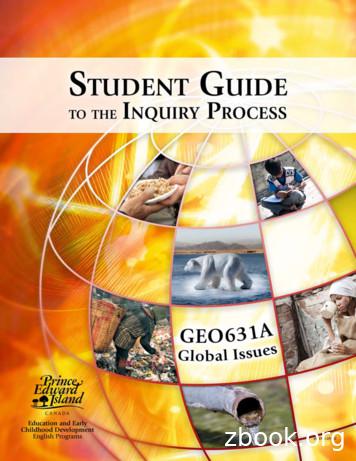INQUIRY 1: WHAT KIND OF FORESTS GROW ON EARTH
INQUIRY 1: WHAT KIND OF FORESTS GROWON EARTH AND HOW DO THEY DIFFER?THE SITUATION: Across the planet, differenttypes of forests are found. One reasondifferent forest types exist is because theygrow under different climates (Figure 5).Another reason is that human activities havechanged some of the forests, for examplethrough planting or felling of trees. To betterunderstand the different types of forestsfound across Earth, the scientists had todecide what was most important about thoseforest differences to study. In other words, tostudy the differences between forests acrossthe planet, FAO had to determine how theywould classify forests.8Before we learn how FAO classified theworld’s forests, let’s think about the place onwhich these forests grow. What is this placecalled?If you guessed Earth, you are right! We knowthat Earth spins on its axis and revolvesGLOSSARY:climate: The average condition of theweather over large areas, over a longtime, or both.classify: To arrange by putting intogroups according to some system.axis: A straight line about which abody or geometric figure rotates.equator: An imaginary circle aroundthe middle of Earth at an equaldistance from the North Pole and theSouth Pole.conserve: To avoid wasteful ordestructive use of something.latitude: Distance north or south of theequator.LegendTArTropical rainforestSCfSubtropical humid forestTeDoTemperate oceanic forestBaTAwaTropical moist deciduous forestSCsSubtropical dry forestTeDcTemperate continental forestBbBoreal coniferous forestBoreal Tundra woodlandTAwbTropical dry forestSBShSubtropical steppeTeBSkTemperate steppeBMBoreal mountain systemTBShTropical shrublandSBWhSubtropical desertTeBWkTemperate desertPPolarTBWhTropical desertSMSubtropical mountain systemTeMTemperate mountain systemTMTropical mountain systemWaterNo dataFigure 5. World ecozone map. An ecozone is a region with similar type of land cover. Notice thatsimilar ecozones can occur on different continents
around the sun (Figure 6).The area near the equator isclosest to the sun. Because ofthis, Earth is warmest near theequator, and coolest near thepoles (Figure 7).About 71 percent of Earth iscovered with water, and mostof this is ocean. The top level ofany ocean is called sea level.The height of the land comparedwith sea level is called elevation.At higher elevations, the climate Figure 6. Earth spins on its axis and revolves around the sunis cooler (Figure 8).Across Earth, different areasreceive different amounts ofrainfall.Plants need water to surviveand have adapted over timeto live with varying amounts of9rainfall. Some plants, such asFigure 7. Earth is warmer near the equator, cooler near the polesthose in tropical rain forests,must have a lot of water tosurvive. Other plants, like thoseMountain-top ice and snowCoolerin deserts, do not need muchAlpine tundra (herbs, lichens, mosses)water to survive. Desert plantshave adapted to conserve theEvergreen forestClimateamount of water they receive.Deciduous forestElevationDrier areas have fewer plantsand trees. Some areas haveTropical forestWarmerSea Levelno plants or trees at all. The3 things that we have justFigure 8. The higher the land’s elevation, the cooler its climateexplored are latitude, elevation,and rainfall (Figures 7-10). TheyEarth’sNorth Pole (90º latitude)affect what kind of forest growsNorthernnaturally in a particular area onHemisphereEarth (Figures 9-10 and 12).CoolertemperaturesPolar (ice)In addition to latitude, elevation,Boreal forests (coniferous[with cones]),and rainfall, there is anothertundra, mountainsinfluence on Earth’s forests. ThisTemperate forests (oceanic forests, continental forests),influence is changing Earth’ssteppe, deserts, mountainsforests, no matter where on EarthSubtropical forests (humid forests, dry forests), steppe,deserts, mountainsthe forests are located. It wasthis influence FAO was mostWarmerTropical forests (rain forests, dry forests, deciduous forests),temperatures shrubland, deserts, mountainsinterested in understanding. WhatEquator (0º latitude)influence did the scientists wantFigure 9. Vegetation types, temperature, and latitudeto understand?
If you guessed humans, you areright! FAO wanted to understandhow forests are changing as aresult of human activity. To studythe influence of humans onforests, the scientists classifiedforests into five categories(Table 1, page 11). Thesecategories were based on howmuch humans have changedthe forest.EquatorWarmTropical shrublandsDesertsTropical dry ous forestsGrasslandsSteppeDeciduous forestsLatitudeSteppeBoreal forestsTundraCoolTundraBoreal forestsTundraPolesRainfallWetDryIf humans have not changeda forest much at all, that forestis made up of native plant andFigure 10. Vegetation types, temperature, and rainfalltree species. Native species arethose that are found in the areanaturally (Table 1, page 11 and Figure 12 ,GLOSSARY:page 12).native: Naturally occurring in an area.Not all forests are made up of native species,and not all forests get their start naturally.10 Trees are planted by people for many reasons.People plant trees to harvest timber in thefuture and for other wood products such aspulp for making paper. When people planttrees for these kinds of products, the resultingforests are called productive plantations.Of course, trees are also planted for foodproducts such as fruits and nuts, but the resultof these plantings are mostly fruit orchards.Fruit orchards were not included among theforest categories by FAO.People also plant trees to achieveenvironmental benefits. Trees may be plantedto protect streams and rivers and to keep soilfrom eroding, a practice called soil and waterconservation. When people plant trees toconserve water quality and soil, the resultingforests are called protective plantations.After FAO had classified forests accordingto human activity, they were ready todiscover how humans were influencing theworld’s forests. They asked each countrycorrespondent to provide information aboutthe characteristics of their country’s forestsaccording to the categories in Table 1 for theyears 1990, 2000, and 2005.species: Groups of organisms thatresemble one another in appearance,behavior, chemical processes, andgenetic structure.ecological: Having to do with ecology,the study of organisms and theirrelationship with their environment.environmental services: Thecollection of environmental processesthat provide benefit to life on Earth.conservation: The care and protectionof natural resources such as forestsand water.ecosystem: A community oforganisms living in an environment asan interdependent system.WHAT THEY DISCOVERED: In 2005, slightlymore than half of all forest area worldwide wasclassified as modified natural forest (Figure11). Remember that modified natural forestscontain native tree species that have grownnaturally but show some signs of humanactivity.In 2005, more than one-third of the world’stotal forest area was classified as primaryforest showing no signs of human activity.
The largest area of primary forest was in theAmazon region of South America. Sevenpercent of the world’s forests were seminatural. Productive and protective plantationsonly made up 3.8 percent of total forestsworldwide. Of this 3.8 percent, 3 percent wasin productive plantations.Between 1990 and 2005, the areas of primaryforest and modified natural forest weredecreasing worldwide. The areas of seminatural forest and forest plantations increasedover the same period. Each year since 1990,about 6 million hectares of primary foresthave been lost or modified. About 2.8 millionTable 1. Categories of forests identified by FAOCATEGORY OFFORESTCHARACTERISTICSDESCRIPTION OF FORESTWITHIN EACH CATEGORYPrimary forestForests with native tree species. Evidence of humanactivities is not visible and the forest’s ecologicalprocesses are not widely disturbed.Modified natural forestForests with native tree species that have grownnaturally. There is evidence of human activities in amodified natural forest. An example is an area wheresome trees were cut in the past.Semi-natural forestForests with native tree species that have grownbecause humans have either sown seeds or plantedsmall trees, or have otherwise assisted the growth ofnative tree species.Productive forest plantationMan-made forests with mostly non-native (and in somecases native) tree species. These forests have beenpurposely planted by humans for the production of woodproducts or non-wood forest products. People create aproductive plantation by sowing seeds or planting smalltrees.Protective forest plantationMan-made forests with mostly non-native (and insome cases native) tree species that have beenpurposely planted by humans for environmentalservices.You Do the Math:What percentage of forestland worldwide wasclassified as either modifiednatural forest or primaryforest?You Do the Math:How many hectares ofproductive plantations areadded every year? Howmany hectares of protectiveplantations are added everyyear?Primary forest36.4%Modified natural forest52.7%Semi-natural forest7.1%Productive forest plantation3.0%Protective forest plantation0.8%Figure 11. Forest characteristics: percent worldwide in eachcategory11
12Figure 12. Some native ecosystems
hectares of forest plantationsare added every year. Of these,87 percent are productiveplantations (Figure 13).REFLECTIONSECTIONDescribethe majorityof forestsworldwide.You caneither use one or twocategories to do this.What are two major trendsin the categories of stplantationmillion ha0200400199060080020001 0001 2001 4001 6002005Figure 13. Changes in different categories of forests from 1990 to2005 (million hectares)THE WORLD'S FORESTS13ForestOther landOther wooded landWater
Deciduous forests Tundra Tundra Boreal forests Boreal forests Figure 10. Vegetation types, temperature, and rainfall If you guessed humans, you are right! FAO wanted to understand how forests are changing as a result of human activity. To study the infl uence of humans on forests, the scientists
Guided inquiry in the Chemistry lAborAtory exPerienCe 15 The degree of inquiry is based on the amount of self-direction by the student compared to directions provided by the teacher. This concept is summed up in the following table: essential Features of Classroom inquiry and Their Variations Essential Feature Open Inquiry Guided Inquiry Structured
Module 1: Introduction to Scientific Inquiry Lesson 1: Scientific Inquiry Activity 4: Misconceptions and Challenges of Scientific Inquiry Estimated Time: 10 minutes What aspect of scientific inquiry are you already doing or what appeals to you about scientific inquiry? Record your ideas below. Modu
John Dewey's Dual Theory of Inquiry and Its Value for the Creation of an Alternative Curriculum Fred Harris, independent scholar Abstract Dewey's theory of inquiry cannot be reduced to the pattern of inquiry common to both common-sense inquiry and scientific inquiry, which is grounded in the human life process, since such a reduction ignores
the brain module responsible for morality was shaped by millions of years of evolution. Based on this line of inquiry, many philosophers argue that, over time, as this line of descriptive inquiry unfolds, it will gradually replace prescriptive inquiry. That is to say, prescriptive inquiry will someday be absorbed by descriptive inquiry in the form of brain science. I don‟t believe it .
to the INQUIRY PROCESS Inquiry Model Refl ecting on the Process. 2 PRINCE EDWARD ISLAND SOCIAL STUDIES CURRICULUM: GEOGRAPHY 631A Guided Practice Selecting a Topic and Planning an Inquiry Outcome 2.1.1 . My biggest challenge with taking notes for this inquiry project will be .
Aug 07, 2014 · Title: Project Accounting-Expenditure Inquiry Document ID: PA0020 Replaces: Project Expenditure Inquiry, PA710 Date Modified: 08/07/2014 Purpose: This procedure details how to perform a Project Expenditure Inquiry-Project (a single project) or a Project Expenditure Inquiry-All (Across
15 BAB II KAJIAN TEORI A. Metode Inquiry 1. Pengertian Inquiry Inquiry adalah istilah dalam bahasa Inggris, yang artinya suatu teknik atau cara yang digunakan guru untuk mengajar di depan kelas.1 Secara umum inquiry adalah proses dimana para saintis mengajukan pertanyaan tentang alam dunia ini dan bagaimana mereka secara sistematis mencari
the Benchmarks for Science Literacy (AAAS, 1993). From a science perspective, inquiry ori-ented instruction engages students in the investigative nature of science, says David L. Haury in his article, Teaching Science through Inquiry (1993). Haury cites scientist Alfred Novak’s definition: “Inquiry is the [set] of behaviors























